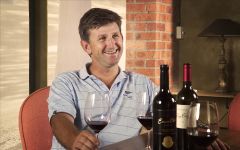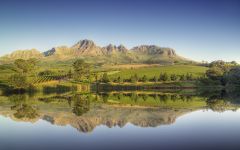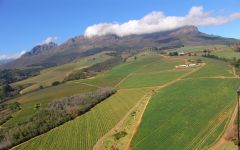Ernie Els Big Easy Red Blend 2010
-
Wine
Enthusiast -
Robert
Parker




Product Details
Your Rating
Somm Note
Winemaker Notes
Blend: 60% Shiraz, 20% Cabernet Sauvignon, 6% Mourvèdre, 6% Grenache, 5% Cinsaut, 3% Viognier
Professional Ratings
- Wine Enthusiast
-
Robert Parker's Wine Advocate
The 2010 Big Easy (Red) is a blend of 67% Shiraz, 16% Cabernet Sauvignon, 6% Cinsault, 4% Mourvedre, 4% Grenache and 3% Viognier. It has a succulent bouquet of dark cherries, mulberry, dark plum and honey that are very well defined. The palate is sweet and rounded on the entry with a slight bittersweet edge. There are copious layers of dark plum-infused fruit laced with tangerine and honey notes. The finish is nicely defined with ample freshness. This is very fine and great value to boot.
Other Vintages
2014-
Wilfred
Wong
-
Robert
Parker -
Wine
Enthusiast






As a leading South African ambassador and one of the most recognizable faces in the world of sports, Ernie Els has long demonstrated a passion for excellence. Focus, discipline and commitment have led to his extraordinary golf success. These same qualities are evident in Ernie Els Wines, a quest to produce premium wine that was born in 1999. Els naturally chose Stellenbosch, South Africa's most storied wine region, to produce his wines and brought on the award-winning Louis Strydom to oversee winemaking. In 2000, the first grapes were crushed for the inaugural vintage of Ernie Els Signature. In 2004, a 178-acre property on the slopes of Helderberg Mountain was chosen as the home of Ernie Els Wines.

With hundreds of red grape varieties to choose from, winemakers have the freedom to create a virtually endless assortment of blended red wines. In many European regions, strict laws are in place determining the set of varieties that may be used, but in the New World, experimentation is permitted and encouraged resulting in a wide variety of red wine styles. Blending can be utilized to enhance balance or create complexity, lending different layers of flavors and aromas. For example, a red wine blend variety that creates a fruity and full-bodied wine would do well combined with one that is naturally high in acidity and tannins. Sometimes small amounts of a particular variety are added to boost color or aromatics. Blending can take place before or after fermentation, with the latter, more popular option giving more control to the winemaker over the final qualities of the wine.
How to Serve Red Wine
A common piece of advice is to serve red wine at “room temperature,” but this suggestion is imprecise. After all, room temperature in January is likely to be quite different than in August, even considering the possible effect of central heating and air conditioning systems. The proper temperature to aim for is 55° F to 60° F for lighter-bodied reds and 60° F to 65° F for fuller-bodied wines.
How Long Does Red Wine Last?
Once opened and re-corked, a bottle stored in a cool, dark environment (like your fridge) will stay fresh and nicely drinkable for a day or two. There are products available that can extend that period by a couple of days. As for unopened bottles, optimal storage means keeping them on their sides in a moderately humid environment at about 57° F. Red wines stored in this manner will stay good – and possibly improve – for anywhere from one year to multiple decades. Assessing how long to hold on to a bottle is a complicated science. If you are planning long-term storage of your reds, seek the advice of a wine professional.

With an important wine renaissance in full swing, impressive red and white bargains abound in South Africa. The country has a particularly long and rich history with winemaking, especially considering its status as part of the “New World.” In the mid-17th century, the lusciously sweet dessert wines of Constantia were highly prized by the European aristocracy. Since then, the South African wine industry has experienced some setbacks due to the phylloxera infestation of the late 1800s and political difficulties throughout the following century.
Today, however, South Africa is increasingly responsible for high-demand, high-quality wines—a blessing to put the country back on the international wine map. Wine production is mainly situated around Cape Town, where the climate is generally warm to hot. But the Benguela Current from Antarctica provides brisk ocean breezes necessary for steady ripening of grapes. Similarly, cooler, high-elevation vineyard sites throughout South Africa offer similar, favorable growing conditions.
South Africa’s wine zones are divided into region, then smaller districts and finally wards, but the country’s wine styles are differentiated more by grape variety than by region. Pinotage, a cross between Pinot Noir and Cinsault, is the country’s “signature” grape, responsible for red-fruit-driven, spicy, earthy reds. When Pinotage is blended with other red varieties, like Cabernet Sauvignon, Merlot, Syrah or Pinot Noir (all commonly vinified alone as well), it is often labeled as a “Cape Blend.” Chenin Blanc (locally known as “Steen”) dominates white wine production, with Chardonnay and Sauvignon Blanc following close behind.
